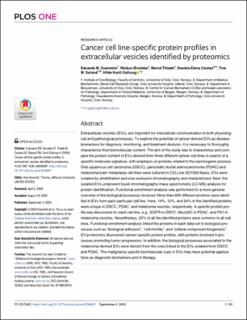| dc.description.abstract | Extracellular vesicles (EVs), are important for intercellular communication in both physiological and pathological processes. To explore the potential of cancer derived EVs as disease biomarkers for diagnosis, monitoring, and treatment decision, it is necessary to thoroughly characterize their biomolecular content. The aim of the study was to characterize and compare the protein content of EVs derived from three different cancer cell lines in search of a specific molecular signature, with emphasis on proteins related to the carcinogenic process. Oral squamous cell carcinoma (OSCC), pancreatic ductal adenocarcinoma (PDAC) and melanoma brain metastasis cell lines were cultured in CELLine AD1000 flasks. EVs were isolated by ultrafiltration and size-exclusion chromatography and characterized. Next, the isolated EVs underwent liquid chromatography-mass spectrometry (LC-MS) analysis for protein identification. Functional enrichment analysis was performed for a more general overview of the biological processes involved. More than 600 different proteins were identified in EVs from each particular cell line. Here, 14%, 10%, and 24% of the identified proteins were unique in OSCC, PDAC, and melanoma vesicles, respectively. A specific protein profile was discovered for each cell line, e.g., EGFR in OSCC, Muc5AC in PDAC, and FN1 in melanoma vesicles. Nevertheless, 25% of all the identified proteins were common to all cell lines. Functional enrichment analysis linked the proteins in each data set to biological processes such as “biological adhesion”, “cell motility”, and “cellular component biogenesis”. EV proteomics discovered cancer-specific protein profiles, with proteins involved in processes promoting tumor progression. In addition, the biological processes associated to the melanoma-derived EVs were distinct from the ones linked to the EVs isolated from OSCC and PDAC. The malignancy specific biomolecular cues in EVs may have potential applications as diagnostic biomarkers and in therapy. | en_US |

